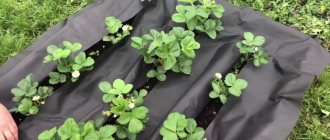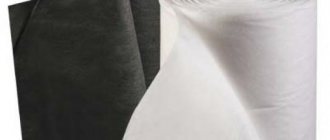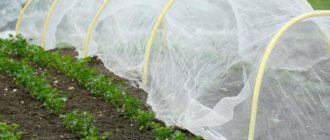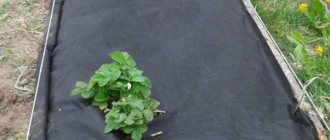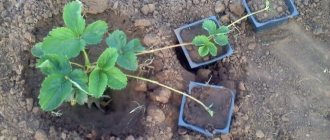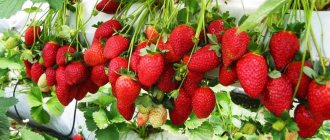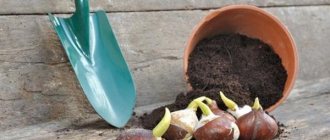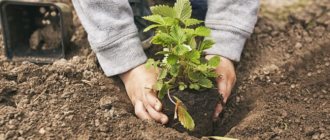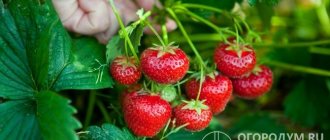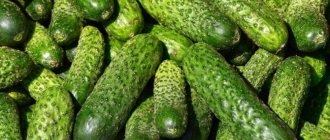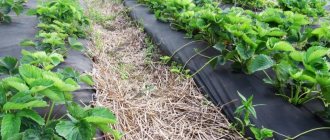Home / Garden / Berries
Back
Published: 01/03/2020
Reading time: 8 min
0
Sweet hard labor - this is what gardeners called strawberry beds until they came to their summer cottages with the technology of growing garden strawberries using agrofibre or film. The unusual method alarmed skeptics, but quickly spread among fans of the experiment.
When the first positive reviews appeared about crops from plantations under cover, agrofibre for strawberries became a panacea. The advantages of growing plants in beds under black covering material so outweighed that they stopped taking the disadvantages into account or learned to minimize the disadvantages.
- 1 Materials for mulching 1.1 Organics
- 1.2 Inorganic mulch
- 4.1 Reinforced
- 5.1 Preparation
Types of non-woven fabric for protecting strawberries
For strawberry beds, choose a black non-woven fabric with a high density. The advantages of agrotextiles over polyethylene are obvious:
- due to the porous structure of the material, the earth breathes and receives rain moisture;
- breathability protects against overheating, rot, and overheating;
- Easier to use: easier to lay, fits without creases.
Common name: agrofibre, agrotextile, covering material. The choice is huge, but for strawberries a density of at least 60 units and a black color are suitable. The diversity is explained by the nuances of technology and the brand of the manufacturer.
Trade names:
- Lutrasil;
- Agrospan;
- Spunbond;
- Agril;
- Spunbel;
- Agrotex.
Any of the brands is suitable for covering strawberry beds. Some of them resemble a mesh, others resemble a cobweb, or a fabric with perforations. Made from polymers in different ways. But the very definition - non-woven - explains that the technology has nothing in common with conventional textiles.
Advantages and disadvantages of the method
Growing strawberries under film has the following advantages:
- No weeds under the covering material. Grass can only grow in holes near strawberry plants and can be easily removed.
- Under the film the ground remains constantly moist. Requires much less water for irrigation compared to the traditional method of growing strawberries.
- The whiskers cannot take root in the shelter. If you want to obtain planting material, they can be cut off and germinate in another place.
- Bushes and berries are much less likely to become infected with pathogens that live in the soil.
- The berries do not come into contact with the soil and do not rot during heavy rainfall.
- On the surface of the covering material, the berries warm up better and ripen faster.
- Pest control is easier. The film becomes a barrier to their penetration into the fruits and leaves.
This method also has disadvantages:
- If the summer is rainy, mold and fungal colonies can develop under the film in the dampness.
- Weeds can grow through the roots and are difficult to remove in this case.
- Additional costs are required for plant protection products.
- Purchasing agrofibre requires large expenses. The more durable the fiber, the more expensive it is.
- To effectively irrigate crops, you will need to install drip irrigation systems.
Rules for using non-woven fabric
Advice for a gardener planning to plant strawberries on agrotextiles for the first time:
- The material is placed on the ground with the smooth side, and the rough, holey side facing the sun. This way, when watering or during rain, water will not roll off the fabric through the holes, but will become saturated. Solar filters also work precisely with this placement.
- The two-layer fabric is also laid correctly: the white side down, the black side up.
- It is better to water the strawberries under the agrofibre at the root, rather than from a hose or watering can. Water that gets on the covering material will be absorbed. But repeated wetting and drying under the sun shortens the life of agrotextiles.
- Light and thin (less than 60 g/m2) will let in not only the sun and water from above, but also weeds from below. A strawberry plantation is set up for several years - there is no point in saving.
- Openings that are too large for planting provide a free path for weeds to escape and for the tendrils to reach the ground. Not only the ends and edges are fixed, but also the holes so that the grass does not break through the edge.
- The slits are made after the material has been thoroughly secured to the bed: otherwise the fabric will move away and the planting pattern will be disrupted.
- A thin white cloth shades the plantation from the scorching sun and protects the berries from birds.
Taking these nuances into account, the gardener can cope with the simple technology of growing strawberries on agrotextiles.
Features of growing strawberries under film
The subtleties of growing strawberries under film:
- The place where the berry rows will be located is dug up to a depth of 15-20 cm.
- Manure and mineral fertilizers are added to the soil.
- The top of the soil is covered with straw, hay, aged compost and other mulching material.
- To protect against pests living in the ground (mice, moles, shrews and others), sheets of cardboard or a metal mesh with small cells are buried under the beds to a depth of 20-25 cm.
- The beds are covered with film.
- Strawberry bushes are planted in slots made at a distance of 20 cm in each row. Row spacing is 65-70 cm.
Film for beds
Black film is used with the same success. But when choosing what to cover the beds with, take into account that:
- polyethylene does not allow moisture to pass through - only drip watering;
- The service life is shorter: it bursts due to frost and heat.
Reinforced
It has a longer service life, since the middle layer is a reinforcing mesh that increases wear resistance. On top of this material is a light shade that reflects light.
A silver or golden coating protects the soil and roots from overheating. The bottom layer – black – suppresses the growth of weeds.
Planting strawberries under black film
The best time to plant strawberries is in late spring and early summer, when the soil is already sufficiently warm. Plant berry bushes in the following sequence:
- Choose a place where nothing has been planted for several years.
- Loosen the soil, break up or remove hard clods of earth.
- Make beds at least 80 cm wide, with a distance between rows of about 70 cm.
- If necessary, apply a layer of mulch (hay, straw, compost, weeded weeds) 20-30 cm thick.
- Leave the prepared area for 8-10 days for the soil to settle. At this time, you need to prepare the irrigation system. It is best to equip the place with drip irrigation.
- Cover the beds with film. There should be no folds or creases. Press the edges of the material securely to the ground or dig it in.
- Make holes for the bushes at a distance of 40 cm. It is better to arrange them in a checkerboard pattern - this way the plants will not interfere with each other. Make 15 cm long cross cuts on the shelter, turning the corners inward.
- Treat strawberry rosettes in a slightly pink solution of potassium permanganate or use another disinfectant.
- Plant strawberry bushes and water (about 1 liter of water per bush).
- Compact the soil around the roots.
- Turn the corners of the cuts on the film outward and cover the ground around the stems with them to prevent weeds from sprouting.
An experienced gardener will tell you about planting strawberries under film in the following video:
Optimal location of beds
Strawberries are photophilous, but also tolerant of partial shade. She loves water and survives short-term flooding, but soil that is too saturated with moisture is contraindicated for her. The best place is an area with a flat surface, well lit and sheltered from the wind.
Both steep slopes and lowlands are not suitable for beds. In the first option, when the snow melts, the ground is washed away, exposing the roots of the bushes, and in the second, the berries take longer to ripen due to lower air temperatures.
The soil should be loosened and cultivated, free from weeds. The depth of underground groundwater on the site must be at least 0.7 m.
Pros of using film
The use of film allows you to create an excellent microclimate for strawberry bushes. This planting method has a wide range of advantages:
- No need to trim your mustache.
- Retains moisture and prevents the appearance of a dry crust on the soil due to the condensation of water droplets.
- The formation of adventitious roots that help strengthen the bushes.
- Almost one hundred percent elimination of infections, due to the lack of contact of leaves and berries with the soil.
- There is no need for mulching and loosening the soil.
- Acceleration of berry ripening.
- Increasing the size and number of berries collected.
- Rare breeding of pests.
- Preventing weed growth.
- Minimizing the time spent caring for strawberries.
Planting strawberries under film is a fairly simple procedure. Even a beginner can cope with it. With minimal hassle, the resulting harvest will delight the gardener.
It is enough to choose a high-quality film and lay it on the soil before planting. The use of film will help to significantly increase the future harvest and make it easier for the gardener to care for the site.
How to choose a film
There are several types of films on sale used to cover beds:
- Black and black-and-white film for strawberries, 40-50 microns thick. It can be purchased in specialized stores for gardeners, as well as in construction stores. The material is quite versatile and is sold in rolls of various widths. Black color was not chosen by chance, since it heats up more than any other in the sun. It is better to choose the black and white version. This film is laid with the black side down and the white side up. The black bottom warms the soil well and prevents weeds from growing. The white top does not overheat in the sun and does not burn the strawberry leaves when the weather is too hot.
- Film with holes made for planting strawberries. This is a completely ready-to-use material. If you still have to tinker with ordinary film, cutting holes for the bushes, here the manufacturer has already taken care of the high accuracy of the distances between individual holes in the rows and row-spacings.
- Mulching film for strawberries with perforations more than 60 microns thick is guaranteed to last for several years. This is very convenient, because strawberries can grow in one place for several years, after which they are completely removed. At the end of the season, the film is inspected for damage, after which the remaining intact and undamaged strips can be reused.
The most commonly used weed film for strawberries is 1.6 or 3.2 m wide. The second option is cut lengthwise into two strips, but a wide ridge can be formed if desired. The width of a standard bed is 1 m, and the remaining overlaps are used to secure the film from being blown away by the wind.
Film selection
There are a large number of films of various colors on the market. It has been noticed that dark colors are best suited for planting strawberries. By attracting heat, such a film promotes increased heating of the soil. This in turn accelerates the onset of berry ripening. Israeli polyethylene is considered the most durable.
There are even varieties of films with round holes for plants. In this case, it becomes much easier to install the floor film.
The width of the film should be chosen based on the planned width of the beds and a thickness of at least 40 microns.
Of course, under a black film the yield will be maximum, but films of other colors will also help prevent the appearance of weeds and protect the berries from rotting.
Non-woven covering material
Non-woven fiber is a modern coating that allows moisture and air to pass through, protects from frost, and suppresses the growth of weeds. There are almost no downsides to such a shelter. The only drawback is that new agrofibre after heavy rainfall may not absorb all the liquid, which leads to the formation of puddles and possible rotting of the berries. Covering material is commercially available under different names:
- Graunkover, Czech Republic
| Color | Life time | pros | Price in rub. per sq.m. |
| Green | Up to 6 years | suppresses weed growth; allows air and moisture to pass through; UV resistant; has markings for easy planting. | 60-80 |
- Spunbond (Lutrasil), Russia
| Color | Life time | pros | Price in rub. per sq.m. |
| White and black | From 3 years | mildew resistant; keeps berries clean; reduces the watering rate by preserving moisture; Rot and mold do not form. | From 15 |
- Agril, Russia
| Color | Life time | pros | Price in rub. per sq.m. |
| White | From 3 years | UV resistant; not susceptible to mold and bacteria; retains soil moisture; Provides rapid heating of the soil. | 15-40 |
Strawberries under agrofibre
When is the best time to plant strawberries under film? Growing strawberries under film: technology features
Strawberries are the most popular berry among domestic gardeners. Thanks to the variety of varieties with great taste that can be eaten for dessert or used for winter preparations, every gardener tries to get the maximum harvest from his dacha. You can get a large number of berries from existing beds by growing strawberries using a little trick - under a film. Instead, farmers sometimes also use agrofibre (agrofilm or spunbond) - a non-woven fabric that can be used for a greenhouse effect or mulching, depending on the color.
Advantages of film for growing berries
Using black film for cultivating strawberries allows you to:
- Eliminate weeds, making maintenance easier. Weed seeds cannot penetrate under the film. Seeds and root shoots of weeds that fall before planting strawberries cannot develop due to the lack of sunlight.
- Get dry, clean berries that do not become dirty or rot from contact with soil or high humidity. The strawberries are located on a slight elevation, so they are well ventilated and dry quickly after rain.
- Receive a harvest faster, since covered beds warm up faster in the spring, and bushes begin flowering earlier than in regular beds. This device retains moisture longer, so during dry periods the bushes under the film bloom and bear fruit more actively.
- Protect strawberry bushes from freezing during spring and autumn frosts. The film is inexpensive and easy to use in agriculture.
These advantages apply only to black film or black agrofibre, which do not transmit light. Materials of other shades do not provide a mulching effect - weeds grow under the cover.
Black film for strawberries has a number of disadvantages:
- It is negatively affected by intense exposure to ultraviolet radiation. After some time, such material bursts and tears (with careful use it lasts for 1-2 seasons).
- The film does not allow air or moisture to pass through, so the soil and strawberry roots overheat in the heat, and this harms the plants. It is also not recommended to use this material for longer than 2 months, since the soil microflora is inhibited and the strawberry ceases to receive the necessary nutrition.
- The use of film material requires additional heating during frost periods - since there is condensation on the inside of the material, frosting occurs on the coating.
Agrofibre, which lasts more than 3 seasons, does not have these disadvantages.
How to properly plant strawberries under black film
- A film that will cover the entire bed in area;
- A hose for drip irrigation, which should be long enough for the entire plantation;
- Suitable varieties of strawberries (not all are recommended to be placed under film);
- Gardening scissors.
Step-by-step preparation includes 6 points:
- The soil must be prepared for planting. In a plot intended for strawberries, it is better not to plant anything for a year or two so that the land is not depleted. During the dormant period, fertilizers should be applied to the soil, and in the fall, treated with a solution to kill weeds.
- The film is laid in the spring. The soil is dug up with a full spade 1-2 weeks before planting. Remove the roots of the weeds and water the soil with fertilizers, and then leave it alone (it should acquire density).
- In order for strawberry bushes to develop well, each bed must be at least 80 cm wide, and the width between rows must be at least 40 cm.
- The bed rises 18-25 cm above the paths - this helps excess moisture drain from the bed during heavy rainfall. Berries ripen faster on the sides of the bed.
- Any lumps of earth that come across are crushed and compacted so that there is a minimum of voids under the shelter.
- The film material is spread on the garden bed and strengthened around the perimeter using “homemade methods” - flat stones, boards, or simply sprinkled with earth until the strawberry bushes take root and grow.
New reflective material
The use of foil in nonwoven materials is a new word in mulching. Previously, this method was used at the stage of growing seedlings, but now the thermal insulation and light reflecting properties, which allow plants to grow faster, have become clear and taken into account. The yield and quality of fruits in areas where there is insufficient sunlight is increased with the use of reflective covering material.
Reflective black and white film for mulching strawberries and other garden crops is a material that has superior properties to the well-known black covering material. A layer of aluminum that reflects sunlight made it possible to improve the mulching of the soil with a covering material.
Mulching is carried out with the black side facing the soil, and the silver side outward, so the black side of the non-woven material inhibits the growth of weeds, and the silver aluminized layer reflects light onto the entire plant, down to the last leaf and fruit ovary.
